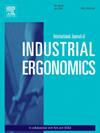Assessment of active back-support exoskeleton on carpentry framing tasks: Muscle activity, range of motion, discomfort, and exertion
IF 2.5
2区 工程技术
Q2 ENGINEERING, INDUSTRIAL
International Journal of Industrial Ergonomics
Pub Date : 2025-03-06
DOI:10.1016/j.ergon.2025.103716
引用次数: 0
Abstract
Despite efforts to reduce work-related musculoskeletal disorders in the construction industry, the challenge persists, particularly among construction trades like carpenters. This study assesses the effectiveness of an active back-support exoskeleton for reducing these disorders during carpentry framing tasks. The assessment encompasses various metrics, including muscle activity, range of motion, perceived discomfort, and perceived exertion. Sixteen participants were engaged in a simulated carpentry framing task, during which data was collected from both subjective evaluations using Borg CR-10 and CR-20 scales and objective measurements employing Electromyography and Inertial Measurement Units. The results are presented through a combination of descriptive and inferential statistics tests. The findings indicate a significant reduction in muscle activity when utilizing the active back-support exoskeleton, with reductions ranging from 16% to 54% across various subtasks. Notably, the right rectus femoris and the left erector spinae experienced more statistically significant reductions in muscle activity in most of the carpentry framing tasks. Dynamic time-warping similarity scores were used to validate the muscle activity results, which show consistency. The use of the exoskeleton also led to a decrease in the range of motion during assembly and nailing subtasks. While the perceived discomfort and exertion did not show statistical significance, there was a reduction in these metrics during exoskeleton-use. This study contributes to the expanding knowledge base on the suitability of exoskeletons in the construction industry. Importantly, it provides a valuable benchmark for evaluating the effectiveness of similar active exoskeletons within the construction sector.
评估主动背部支撑外骨骼在木工框架任务:肌肉活动,运动范围,不适和用力
尽管建筑行业努力减少与工作相关的肌肉骨骼疾病,但挑战依然存在,尤其是在木匠等建筑行业。本研究评估了主动背部支持外骨骼在木工框架任务期间减少这些疾病的有效性。评估包括各种指标,包括肌肉活动,运动范围,感知不适感和感知用力。16名参与者参与了模拟木工框架任务,在此过程中,数据收集来自博格CR-10和CR-20量表的主观评估和肌电图和惯性测量单元的客观测量。结果是通过描述性和推理统计检验的组合提出的。研究结果表明,当使用主动背部支撑外骨骼时,肌肉活动显著减少,在不同的子任务中减少幅度从16%到54%不等。值得注意的是,在大多数木工框架任务中,右股直肌和左竖脊肌的肌肉活动在统计上更显着减少。动态时间扭曲相似度评分用于验证肌肉活动结果,显示一致性。外骨骼的使用也导致装配和钉子任务期间运动范围的减少。虽然感知到的不适和劳累没有显示出统计学意义,但在使用外骨骼期间,这些指标有所减少。这项研究有助于扩大外骨骼在建筑行业适用性的知识库。重要的是,它为评估建筑行业中类似活性外骨骼的有效性提供了一个有价值的基准。
本文章由计算机程序翻译,如有差异,请以英文原文为准。
求助全文
约1分钟内获得全文
求助全文
来源期刊
CiteScore
6.40
自引率
12.90%
发文量
110
审稿时长
56 days
期刊介绍:
The journal publishes original contributions that add to our understanding of the role of humans in today systems and the interactions thereof with various system components. The journal typically covers the following areas: industrial and occupational ergonomics, design of systems, tools and equipment, human performance measurement and modeling, human productivity, humans in technologically complex systems, and safety. The focus of the articles includes basic theoretical advances, applications, case studies, new methodologies and procedures; and empirical studies.

 求助内容:
求助内容: 应助结果提醒方式:
应助结果提醒方式:


